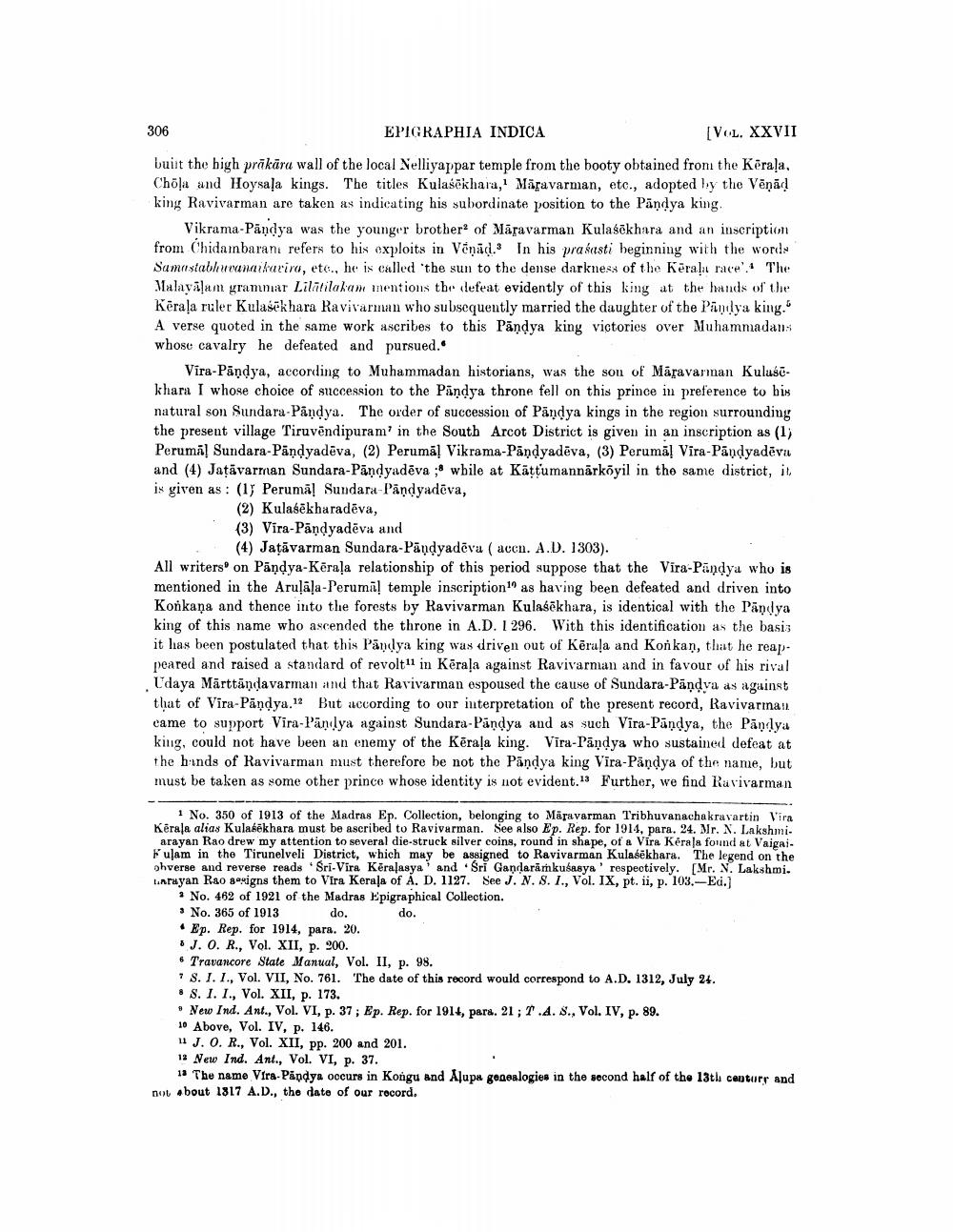________________
306
EPIGRAPHIA INDICA
[VOL. XXVII
built the high prākāra wall of the local Nelliyappar temple from the booty obtained from the Kēraļa, Chola and Hoysala kings. The titles Kulasēkhara, Märavarman, etc., adopted by the Vēņād king Ravivarman are taken as indicating his subordinate position to the Pāndya king.
Vikrama-Pāndya was the younger brother of Māsavarman Kulasēkhara and an inscription from Chidambaran refers to his exploits in Vēnād. In his prasasti beginning with the words Sama stabhuvana karira, etc., he is called the sun to the dense darkness of the Kēralı race': The Malavālam grammar Lilililakan mentions the defeat evidently of this king at the hands of the Kēraļa ruler Kulasekhara Ravivarman who subsequently married the daughter of the Pandya king. A verse quoted in the same work ascribes to this Pāndya king victories over Muhammadans whose cavalry he defeated and pursued.
Vira-Pandya, according to Muhammadan historians, was the son of Máravarman Kulusokhara I whose choice of succession to the Pandya throne fell on this prince in preference to his natural son Sundara-Pāndya. The order of succession of Pāndya kings in the region surrounding the present village Tiruvēndipuram' in the South Arcot District is given in an inscription as (1) Perumā! Sundara-Pāņdyadēva, (2) Perumā! Vikrama-Pāndyadēva, (3) Perumā! Vira-Pāņdyadēva and (4) Jațăvarman Sundara-Pāndyadēva ;a while at Kättumannärköyil in the same district, it is given as: (1) Perumā! Sundara-Pandyadēva,
(2) Kulasēkharadēva, (3) Vira-Pāndyadeva and
(4) Jaţāvarman Sundara-Pāņdyadēva ( acen. A.D. 1303). All writers' on Pandya-Kerala relationship of this period suppose that the Vira-Pandya who is mentioned in the Aruļā!a-Perumi! temple inscription" as having been defeated and driven into Konkaņa and thence into the forests by Ravivarman Kulasēkhara, is identical with the Pandya king of this name who ascended the throne in A.D. 1 296. With this identification as the basis it has been postulated that this Pandya king was driven out of Kerala and Konkan, that he reappeared and raised a standard of revolt11 in Kerala against Ravivarman and in favour of his rival l'daya Märttändavarman and that Ravivarman espoused the cause of Sundara-Pāņdya as against that of Vira-Pandya.12 But according to our interpretation of the present record, Ravivartan. came to support Vira-Pānılya against Sundara-Pandya and as such Vira-Pandya, the Pandya king, could not have been an enemy of the Kerala king. Vira-Pandya who sustained defeat at the hands of Ravivarman must therefore be not the Pandya king Vira-Pandya of the name, but must be taken as some other prince whose identity is not evident. Further, we find Ravivarman
1 No. 350 of 1913 of the Madras Ep. Collection, belonging to Māravarman Tribhuvanachakravartin Vira Kerala alias Kulasēkhara must be ascribed to Ravivarman. See also Ep. Rep. for 1914, para. 24. Mr. N. Lakshmi.
uck silver coins, round in shape, of a Vira Kerala found at Vaigai. Fulam in the Tirunelveli District, which may be assigned to Ravivarman Kulasekhara. The legend on the ohverse and reverse reads Sri-Vira Keralasya' and Sri Gandarāmkušasya' respectively. [Mr. N. Lakshmi. Larayan Rao gesigns them to Vira Kerala of A. D. 1127. See J. N. 8. I., Vol. IX, pt. ii, p. 103.--Ed.)
· No. 462 of 1921 of the Madras Epigraphical Collection. * No. 365 of 1913 do. do. • Ep. Rep. for 1914, para. 20. * J. O. R., Vol. XII, p. 900. 6 Travancore State Manual, Vol. II, p. 98. 7 8. 1. 1., Vol. VII, No. 761. The date of this record would correspond to A.D. 1312, July 24.
S. I. I., Vol. XII, p. 173. New Ind. Ant., Vol. VI, p. 37; Ep. Rep. for 1914, pars. 21; T.4. ., Vol. IV, p. 89. 10 Above, Vol. IV, p. 146. HJ. O. R., Vol. XII, pp. 200 and 201. 12 New Ind. Ant., Vol. VI, p. 37.
13 The name Vira-Pandya occurs in Kongu and Alupa genealogies in the second half of the 13th centure and not about 1817 A.D., the date of our rocord.




